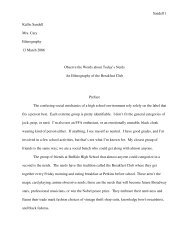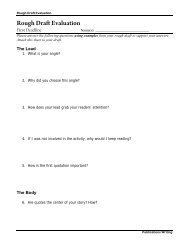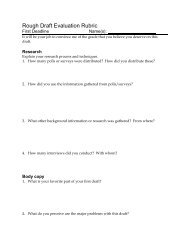Course Description and Outline - McCallum's Connected Classroom
Course Description and Outline - McCallum's Connected Classroom
Course Description and Outline - McCallum's Connected Classroom
- No tags were found...
Create successful ePaper yourself
Turn your PDF publications into a flip-book with our unique Google optimized e-Paper software.
Philosophy:Publications WritingMr. Ryan McCallum • Room A-210 • 682-8162rmccallum@buffalo.k12.mn.us • www.bhs.ccPublications Writing is a h<strong>and</strong>s-on opportunity for you to learn responsible habits while producing theyearbook; a historical written <strong>and</strong> pictorial reference which chronicles the events of the school year. The endresult includes not only a quality product, but also allows you the opportunity to learn <strong>and</strong> grow through thish<strong>and</strong>s-on process. You will learn more than yearbook fundamentals; you’ll learn to manage time, become selfstarters,delegate responsibility, demonstrate knowledge, share resources, manage money <strong>and</strong> receipts, <strong>and</strong>motivate co-workers, much like in the business <strong>and</strong> journalistic world.Goals:The goal of Publications Writing is to create a yearbook which adheres to strict journalistic guidelines. In orderto achieve this goal, the course requires several weeks of intensive training with the remainder of the year to beused as a lab for yearbook production. Some objectives will take longer to master, while students withjournalistic or yearbook background may only need a review. The course content includes but is not limited to:layout construction, article <strong>and</strong> body copy development, use of graphic designs, time management, businessprocedures, publisher requirements, <strong>and</strong> photo appreciation.Performance Objectives:Anatomy of a YearbookThe student will:• Learn the five functions of a yearbook <strong>and</strong> know how this current book will serve those functions• Develop an awareness of the history of yearbooks <strong>and</strong> yearbook production• Underst<strong>and</strong> the purpose of each part of the yearbook <strong>and</strong> how the parts are assembled.• Become familiar with printing terms <strong>and</strong> concepts as they relate to yearbook production.Theme DevelopmentThe student will:• Recognize how a theme provides continuity <strong>and</strong> creates a unique personality for the yearbook• Learn how a yearbook theme is developed• Engage in brainstorming <strong>and</strong> apply this strategy to creative endeavors.Coverage <strong>and</strong> ContentThe student will:• Underst<strong>and</strong> the terms coverage <strong>and</strong> content• Learn ways of making content more interesting <strong>and</strong> techniques for structuring that content• Improve the quality of writing by reporting on people <strong>and</strong> events in different <strong>and</strong> unusual ways.LayoutThe student will:• Create an organized design in the layout• Learn about the elements involved in creating a layout <strong>and</strong> know the importance of designing doublepagespreads.• Arrange design elements in a creative orderly fashion.• Recognize layout <strong>and</strong> column styles that can be used to create consistency throughout a section.
Copy WritingThe student will:• Underst<strong>and</strong> the importance of solid copy writing• Learn the difference between news <strong>and</strong> feature writing styles• Recognize captions <strong>and</strong> headlines as important parts of yearbook copy• Prepare interview questions <strong>and</strong> material• Conduct interviews <strong>and</strong> create surveys <strong>and</strong> polls to gather material• Learn how to organize information gathered in an interview in preparation for writing a story.Writing the StoryThe student will:• Define various types of leads <strong>and</strong> write a lead appropriate to the story• Recognize the three basic types of quotes in a story• Memorize the characteristics of well-written copy• Use the rules of headline writing• Underst<strong>and</strong> the placement <strong>and</strong> headline design.The CaptionThe student will• Underst<strong>and</strong> how complete captions make the yearbook an accurate record of the year• Work with photographers to collect the information needed to write complete captions• Write <strong>and</strong> design captions that are informative.Proofreading <strong>and</strong> Editing:The student will:• Underst<strong>and</strong> the purpose <strong>and</strong> value of proofreading yearbook copy• Learn the proofreading guidelines <strong>and</strong> tools <strong>and</strong> know how to use them.TypographyThe student will:• Develop <strong>and</strong> awareness of the role typography plays in the presentation of yearbook content• Learn primary kinds of type <strong>and</strong> how they are classified• Learn how type is measured• Demonstrate underst<strong>and</strong>ing of how to use typography effectively.PhotographyThe student will:• Recognize the value of quality pictures in the yearbook• Recognize the rule of photographic composition• Recognize common photographic problems• Prepare a photograph for submission using Adobe PhotoShop CS3• Underst<strong>and</strong> how cropping can improve pictures composition.Computer PreparationThe student will:• Underst<strong>and</strong> the purpose of copy fitting the variables affecting copy depth <strong>and</strong> adjust their stories to fit increated layout spreads• Learn how to use the Adobe InDesign CS3 program to prepare copy for submission• Learn the steps used in fitting yearbook texts, preparing layouts, adding photos, <strong>and</strong> digital submission.
Grading:1/3 of your grade is based on points earned on quizzes <strong>and</strong> tests, homework, <strong>and</strong> in-class assignments.2/3 of your grade is based on your deadline assignments, which consists of:• Research <strong>and</strong> preparation• First draft• Revisions• AttitudeIn order for me to grade you on the specifics listed above, you will complete a “Deadline Evaluation Rubric.”This packet of questions will allow you to convince me of the grade you think you deserve. You will collect allof your “proof” in a two-pocket folder, which you will h<strong>and</strong> in with your “Deadline Evaluation Rubric.” Irepeat, ALL of your work will go into your deadline folder:• All drafts (revisions, final draft)• Proof of photos taken• Polls/Interview questions• A tally of situations in which you helped others.A+ 98 – 100% B+ 87 – 89% C+ 77 – 79% D+ 67 – 69%A 94 – 97% B 83 – 86% C 73 – 76% D 63 – 66%A- 90 – 93% B- 80 – 82% C- 70 – 72% D- 60 – 62%Materials Needed:A notebook • One three-ring binder (for all h<strong>and</strong>outs) • Two two-pocket folders (one is for a Deadline Folder)Respect:The way you treat others dictates how you are treated. At all times during this class, you are expected to treatyour teacher <strong>and</strong> classmates respectfully. It is your responsibility to ensure that learning is taking place byhelping everyone feel safe <strong>and</strong> comfortable. Be courteous to others who use this classroom <strong>and</strong> to those whoclean <strong>and</strong> maintain it by keeping it as clean as possible.Challenge ideas, but never criticize your classmates.Responsibility:Please keep in mind the following specific rules:• Please be in your seat when the bell rings to start class, <strong>and</strong> do not line up by the door at the end of class.• Please do not bring headphones, radios, CD players, telephones, or electronic games, to class• Please do not bring food or drink to class. (Only water in clear containers is allowed.)• Please actively participate in class. You will be asked to leave the room if your head is on the table or if youare found sleeping. Take care of yourself <strong>and</strong> assure that you are sleeping well each night.• Do not leave the room without signing out <strong>and</strong> taking a pass.Online: bhs.ccThere are numerous online tools that you will be expected to use as a part of the class. The course website, located at bhs.cc, alsocontains detailed summaries of each day of class – including copies of h<strong>and</strong>outs, notes, <strong>and</strong> other materials. If you are absent, you willbe expected to visit the website to learn what you missed. You will be required to make at least 20 posts per term on the class Forums(or Message Board). To qualify for credit, your posts must begin or contribute to discussion. Posting your work for critique or offeringcritique on the work of classmates is the most valuable thing you can do on the Forum. You will also contribute work to the BHS WikiProject <strong>and</strong> hoofprint.net. Students will use Google Docs <strong>and</strong> Google Talk through bhs.cc. This part of the class is not optional orsecondary. All students will be expected <strong>and</strong> required to use these tools. More instructions will be available when the class beginsusing these tools.
Publications Writing Attendance <strong>and</strong> Class Rules ContractAs you will soon find out, this class will lead you out of the classroom to hunt down information <strong>and</strong> resources.Even though you will be leaving for specific yearbook assignments, I must know where you are going. The ideaof strapping tracking devises crossed my mind, but I figured that the only reasonable way to keep tabs oneveryone’s destination is to use passes <strong>and</strong> a sign out clipboard. I know that by insisting on this rule I make yourquick trip to the library or office a little less quick, but trust me, there’s nothing that annoys me more than tryingto find one of my students during the class period.When you are absent, I will give you a “When you were gone…”half sheet of paper describing what you missed<strong>and</strong> I will attach all h<strong>and</strong>outs to it. School policy states that you will be given a maximum of two days for eachday missed to complete make-up work. This policy works for me.Late work earns credit at my discretion. Please keep in mind, however, that once I have h<strong>and</strong>ed corrected papersback to the class, I cannot accept late work for points. Late drafts <strong>and</strong> stories are absolutely unacceptable.As you may already know, BHS is striving to gain better records of absences <strong>and</strong> tardies. Therefore, if you arenot in class when the period begins, I will mark you absent. If you are a few minutes late to class, just sign theclipboard by the door <strong>and</strong> clip your pass to the board. This will help me remember to mark you tardy instead ofabsent in SASI. With two unexcused tardies, I will start to wonder where this class is on your priority list <strong>and</strong>you will have to make you time with me before school, after school, or during AAA. With this consequence, Idon’t anticipate any more tardies, but if you insist on rolling in without a pink pass again, I will not hesitate tocall home.From past experience, I have learned that the very beginning <strong>and</strong> very end of class can be some of the mostproduct time or the most wasteful time spent in the classroom. I have a few requests: At the start of the classperiod, please allow me to take attendance <strong>and</strong> make announcements without disruption. Disruption meansasking me questions that I could have answered before the class started <strong>and</strong>/or behavior that distracts me fromgetting initial procedures out of the way. Additionally, please stay seated <strong>and</strong>/or working until the bell rings atthe end of the block. If I find you st<strong>and</strong>ing at the door waiting for the bell, it will indicate to me that you don nothave enough work to do.There may be many times during some class periods where you feel like you have “nothing to do.” Resist theurge to accept this feeling, for when you are a part of a group process you always have “something to do.”When in doubt, see your editor. Chances are somebody will have something for you to do.This class requires that we, as individuals, practice respect for each other <strong>and</strong> our differences. I expect respectwhen I am in front of the room, which means I need you to be quiet while I am speaking. I refuse to talk above30 students’ voices. All I ask is that you listen.Also, you must respect the fact that this class requires hard work. At some point you will probably be asked todo something over. Don’t complain, <strong>and</strong> please don’t whine. I assure you that our “product” will be worth all ofyour efforts.Yes, I have read the rules <strong>and</strong> reminders for the publications writing course.Sign here: _______________________________________ Date: ___________________
















